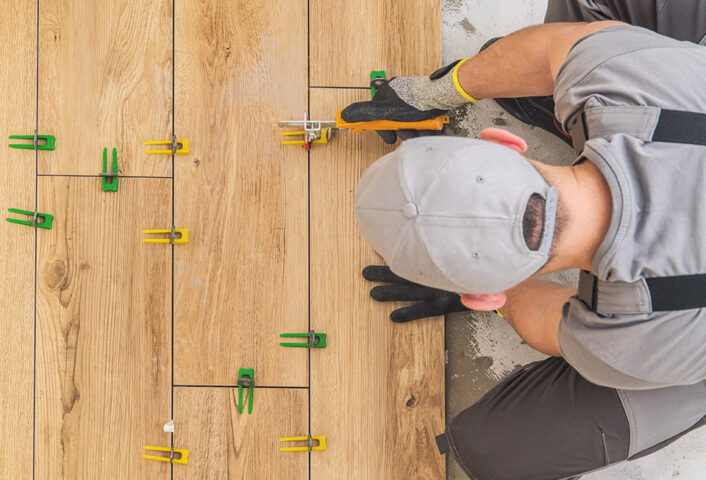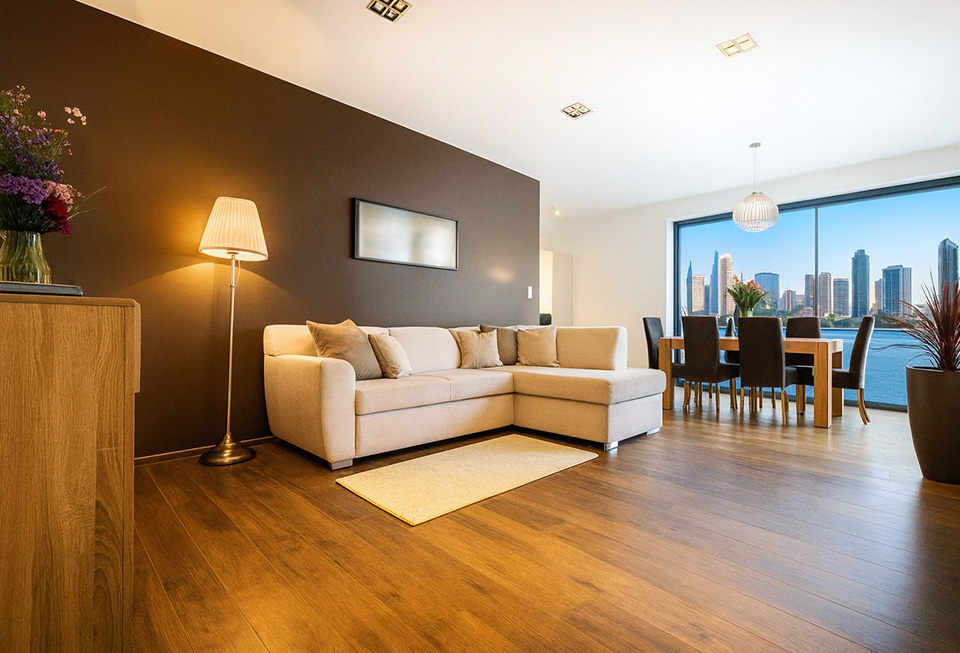
How to Apply Limewash Paint: Step-by-Step Instructions
May 16, 2025
Benjamin Moore vs Behr Paint: Which Brand is Right for You?
May 28, 2025Choosing the right type of flooring is a big decision for any homeowner, especially when you’re stuck between two of the most popular options: hardwood and engineered wood.
If you’re renovating or building in San Diego, this choice can feel even more overwhelming. The coastal climate, real estate market, and diverse range of home styles across the region mean your flooring choice needs to be more than just stylish; it needs to be practical, durable, and suited to your lifestyle.
This is where a flooring company in San Diego can really make a difference. With firsthand knowledge of local conditions and design trends, their guidance can help you confidently choose the right flooring for your home, family, and budget.
What’s the difference between hardwood and engineered wood flooring?
Solid hardwood flooring is made from a single piece of timber. It’s milled from real wood like oak, walnut, or maple, offering a classic, natural look and feel. Engineered wood, on the other hand, is constructed using several layers. The top layer is real hardwood, while the base layers are typically made from plywood or high-density fiberboard.
Visually, both types can look almost identical once installed. Structurally, though, engineered wood is more stable due to its layered construction. A common misconception is that engineered wood is a “cheap imitation.” In reality, many premium engineered options use the same top-quality wood as solid hardwood.
Another key difference comes down to how each type handles moisture and temperature changes. Solid hardwood tends to expand and contract with the weather, something to think about in San Diego, where coastal humidity can sneak in. Engineered wood handles those changes better, making it a smart choice for areas like kitchens, second floors, or homes near the beach.
If you’re into DIY, engineered wood also has a slight edge; it can sometimes be floated over an underlayment without nails or glue. That said, both types look amazing when installed professionally, and each has its own charm. It really comes down to your lifestyle, your budget, and where the flooring is going in your home.
Still torn between the two? A quick chat with a flooring company in San Diego can help you weigh up which one suits your home best.
Which flooring type performs better in San Diego’s coastal climate?
Humidity, temperature changes, and salty air all play a role in how flooring materials behave. In coastal areas of San Diego, like La Jolla or Pacific Beach, humidity levels fluctuate more than they do inland. Solid hardwood tends to expand and contract with moisture, which can lead to warping or gapping over time. Engineered wood’s layered design makes it more resistant to this kind of movement.
If you’re living steps from the beach or have windows open often for that fresh ocean breeze, engineered wood tends to hold up better in the long run. Plus, it still gives you that natural wood look, so you don’t have to compromise on aesthetics.
For inland areas like Poway or Escondido, either option can work well. But when you’re living closer to the coast, a flooring company in San Diego will usually lean toward engineered wood for better long-term performance and fewer moisture-related headaches.
Is hardwood flooring more durable than engineered wood?
When it comes to everyday wear and tear, both options are quite resilient, especially if you’re choosing high-quality materials. However, solid hardwood has a slight edge in durability simply because it can be sanded and refinished more times over its lifetime. Engineered wood can also be refinished, but only if the top veneer is thick enough.
That said, many families in San Diego opt for engineered wood because it’s still tough enough to handle kids, pets, and the occasional dropped toy or kitchen mishap. If your floors do start to show signs of age after a few years, there are plenty of ways to refresh the finish without replacing the whole thing.
The best way to determine which option suits your household is to speak with a local professional. A flooring company in San Diego can assess your home’s traffic levels, future renovation plans, and lifestyle needs to help you make the right durability decision.
How does each flooring option handle moisture and spills?
Moisture is always a concern in kitchens, bathrooms, and even basements. While neither hardwood nor engineered wood is completely waterproof, engineered wood generally handles moisture better. The layers in engineered flooring create a barrier that helps prevent water from seeping through and damaging the structure.
If your kitchen sees a lot of cooking action or your bathroom doesn’t have the best ventilation, engineered wood is a safer bet. It’s also great for households with young kids or pets who might occasionally bring in water from outside.
If you’re planning to install new floors in a part of your home that’s prone to spills or humidity, a flooring company in San Diego will often recommend engineered wood as a more forgiving option. They also take into account the layout and airflow of your space when making this call, so you’re not left dealing with swelling planks or soft spots.
Which option offers the best return on investment for San Diego homes?
Hardwood flooring often holds more resale value because of its perceived luxury and timelessness. However, engineered wood isn’t far behind. In fact, modern engineered options can offer nearly the same boost to your property value, especially when they’re installed professionally and maintained well.
Buyers love a home with beautiful, move-in-ready floors, whether they’re solid or engineered. In areas like Del Mar or Coronado, where home values are already high, upgraded wood flooring can help your listing stand out.
A flooring company in San Diego will have seen countless remodels and staging projects. They know what today’s homebuyers want and can advise you on which flooring will make your home more attractive in the current market.
How do installation processes compare for hardwood and engineered wood?
Installing solid hardwood typically involves a longer and more labor-intensive process. It may require nailing or stapling planks into a subfloor, which adds to the installation time and cost. Engineered wood can often be floated or glued down, making the process faster and more cost-effective.
If you’re in a hurry to wrap up renovations or just don’t want your home turned upside down for a week, engineered flooring is often the faster route. Some types even come with click-lock systems that make the job even quicker.
A flooring company in San Diego will consider your subfloor material, home layout, and timeline to recommend the smoothest installation path. Their trained installers ensure that your floors are laid properly the first time, avoiding costly rework.
Is engineered wood more eco-friendly than hardwood?
Engineered wood is often considered the more sustainable choice because it uses less hardwood overall and makes efficient use of fast-growing trees for its base layers. Some products even come with environmental certifications like FSC or GreenGuard, which are great indicators of responsible sourcing.
Plus, because it uses a real hardwood top layer, you still get the warmth and beauty of traditional wood flooring without needing to harvest as much raw timber.
A flooring company in San Diego would keep eco-conscious homeowners in mind and can introduce you to brands that prioritize sustainability without compromising on style or quality. If going green is important to you, they’ll help you pick a floor that aligns with your values and looks good doing it.
What are the cost differences between hardwood and engineered wood?
Solid hardwood typically costs more upfront, both in terms of material and installation. Engineered wood is generally more affordable and can save you money on labor, especially if it’s designed for floating installation.
To avoid budget surprises, a flooring company in San Diego can give you a clear, detailed estimate that includes materials, labor, and any prep work needed before installation begins. Some even offer in-home consultations, so you know exactly what to expect from start to finish.
How do style and aesthetic options compare?
Both hardwood and engineered wood offer a ton of design flexibility, so you don’t have to compromise on style, no matter which one you choose. From timeless oak and maple to exotic acacia or teak, you’ll find plenty of stunning choices in both categories. Engineered wood also tends to push the boundaries a bit more, with trendy finishes like wire-brushed textures, whitewashing, and extra-wide planks that give your space a modern, airy vibe.
That’s especially helpful in San Diego homes where the coastal light plays a big role in how colours appear throughout the day. Whether you’re going for the relaxed vibe of a Pacific Beach bungalow or the earthy tones of a Rancho Santa Fe estate, local showrooms in San Diego offer curated samples to match the regional architecture. Plus, design consultants can help you layer your flooring choices with furniture, cabinetry, and wall colours for a cohesive look.
Which flooring type is better for active families or pets?
If you’ve got kids running around or pets zooming through the hallways, you’ll want flooring that keeps up. Engineered wood often comes prefinished with highly durable topcoats that are scratch- and dent-resistant. That makes it a strong choice for high-traffic zones like living rooms, kitchens, or playrooms.
Hardwood, on the other hand, can be a bit more high-maintenance. It’s sturdy, sure, but over time, it can show signs of wear like scratches from pet claws or toys. The good news? You can sand and refinish it multiple times, which means you can bring it back to life when needed.
A flooring company in San Diego would almost always recommend engineered wood for young families because it’s tough and fuss-free, but if you’re more about the long game and don’t mind a little upkeep, solid hardwood could still be a great match.
Can you use either option with underfloor heating systems?
Yes, but with some caveats. Radiant heating is a growing trend in San Diego, especially in cooler inland areas or luxe bathroom remodels. Engineered wood is the more flexible choice here. Its multi-layer core is less sensitive to temperature changes, which means it expands and contracts less, perfect for underfloor heating.
Some hardwood species don’t play nicely with heat, especially denser types that are more prone to movement. If you’re dead set on hardwood with radiant heat, you’ll want to work with a local installer who can recommend the right wood species and installation method.
In either case, it’s smart to loop in a San Diego flooring company early in the process. They’ll make sure your floor and heating system work together without issues, and that you stay cozy in the cooler months without worrying about warping.
How long does each flooring type typically last in San Diego homes?
With the right care, solid hardwood can easily last 50 years or more. Think of it as a long-term investment. It’s not unusual to see original hardwood floors in historic homes across San Diego that still look beautiful decades later.
Engineered wood tends to last 20 to 30 years, depending on the quality and wear layer thickness. That’s still a solid lifespan, especially for modern families who may renovate again before then. Higher-end engineered wood can even push beyond the 30-year mark with proper maintenance.
A flooring company in San Diego would often provide maintenance guides or even schedule check-ins to help extend the life of your floors. Whether you’re living by the beach or in the hills, a little TLC goes a long way.
What kind of maintenance does each option require?
The day-to-day upkeep for both types is pretty similar; regular sweeping, occasional vacuuming, and mopping with a wood-safe cleaner will keep things looking fresh. But over time, hardwood does require more commitment. You’ll likely need to sand and refinish it every 7–10 years to get rid of scratches or dullness.
Engineered wood is a bit more “set it and forget it.” It’s designed to maintain its look longer without refinishing, especially if you opt for a tough factory-applied finish. That said, you’ll still want to use furniture pads, avoid harsh chemicals, and clean up spills quickly. Many San Diego flooring companies offer cleaning products that are safe for both types of wood, and some even offer periodic deep-cleaning services if you’d rather leave it to the pros.
Can you refinish engineered wood like you can with hardwood?
Engineered wood has a thin layer of real hardwood on top, called a wear layer. If that layer is 3mm or more, you can usually sand and refinish it once or twice over its lifespan. If it’s thinner, it might only handle a light buff or touch-up.
That’s why it’s important to ask about the wear layer before buying. San Diego flooring pros can measure it for you and let you know what to expect down the line. And if refinishing is a must-have for you, they’ll steer you toward options that give you that flexibility.
What should you know about subfloors before choosing a flooring type?
Your subfloor is the unsung hero of your flooring project. Whether you’re working with plywood, concrete, or an existing floor, its condition matters a lot. Hardwood generally requires a sturdy, dry, and level plywood subfloor to avoid squeaks and movement.
Engineered wood is more forgiving. It can often be installed directly over concrete with the right moisture barriers, which makes it a great choice for ground-level or multi-family units in San Diego. Floating installations can even go over existing tile or laminate in some cases, saving you time and money.
Before laying a single plank, a local flooring company will inspect your subfloor and suggest any necessary prep work, such as levelling or moisture mitigation. That extra step ensures your new floors stay beautiful and stable for years.
How can a flooring company help you make the right choice for your space?
Choosing between hardwood and engineered wood isn’t just about looks. It’s about how you live, where you live, and what your home demands. A flooring company in San Diego offers in-home consultations, takes precise measurements, and brings samples to help you visualize the final result.
Their tailored advice takes all the guesswork out of the process, helping you choose a product that feels right, looks stunning, and lasts for years.
What are some real-life examples of hardwood vs. engineered wood in San Diego homes?
In coastal homes, engineered wood often shines thanks to its moisture resistance and dimensional stability. For example, a Mission Beach remodel used wide-plank engineered oak for its breezy, modern appeal. Meanwhile, a historic home in Bankers Hill went with solid hardwood to preserve its traditional charm.
Flooring companies often have before-and-after galleries or customer testimonials to show how both materials have performed across different San Diego suburbs.
What questions should you ask a flooring company before choosing?
Ask about the product’s origin, how it handles moisture, what warranties are included, and how long installation will take. Find out whether they offer after-sales support and what kind of maintenance services are available. Be sure to ask if they follow up post-installation to ensure satisfaction.
Vetting a flooring company in San Diego also means checking online reviews, licenses, and asking for photos of past work in homes similar to yours.
How can you get a free estimate or consultation in San Diego?
Most flooring companies offer free quotes. You can request an in-home consultation, schedule a showroom appointment, or even set up a virtual meeting. Consultations typically include a full measurement of your space, product suggestions, and a detailed estimate.
Before your visit, take note of any issues in your current flooring, think about how each room is used, and gather some design inspiration to help guide the conversation.
Frequently Asked Questions
Below some additional questions to consider:
What’s the difference between solid hardwood and engineered wood flooring?
Solid hardwood is made from a single piece of wood, offering a traditional and long-lasting look. Engineered wood has a hardwood top layer bonded to layers of plywood, making it more resistant to moisture and temperature changes, ideal for San Diego homes, especially near the coast.
Can I install new flooring during the rainy season?
Yes, but extra precautions might be necessary. Even though San Diego doesn’t experience heavy rainfall often, increased humidity can affect certain materials like solid hardwood. Your installer may use dehumidifiers or recommend acclimating materials for a longer period before installation.
Do flooring companies in San Diego provide free estimates?
Most reputable flooring companies offer free in-home estimates so they can assess your space, measure accurately, and recommend the best flooring options. Be sure to ask whether the estimate includes everything from labor and materials to removal and disposal of old floors.
How do I maintain my new floors after installation?
Each flooring type has its own care routine. For instance, vinyl and laminate are easy to clean with regular sweeping and damp mopping. Engineered wood benefits from dry cleaning and occasional polishing. Your installer should provide care instructions specific to your flooring type.
Is flooring installation messy?
It can be, but a professional installer will take steps to minimize dust and debris. Expect some noise and disruptions, but most crews lay down protective coverings, use dust-containment tools, and clean up after the job is done.
Let a flooring company in San Diego help you decide
With so many factors to consider, it’s easy to feel overwhelmed. That’s why teaming up with a flooring company in San Diego can make all the difference. Their local knowledge, product range, and customer-first approach mean you’ll get a flooring solution that’s not only beautiful but also practical and long-lasting. Get in touch with professional floor installation services in San Diego today.

